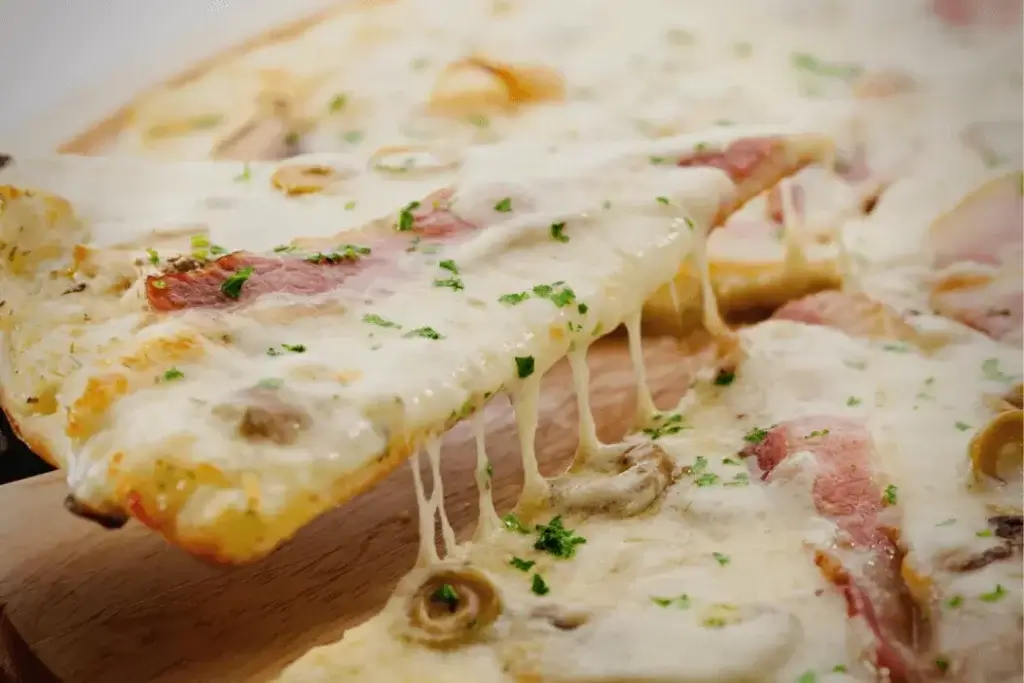It may not be easy to let go of things, particularly food that we have diligently prepared from scratch, especially when we are all working to limit the amount of food that we throw away. However, whether or not Alfredo sauce can be frozen arises.
As long as you take the necessary safety measures. Although dairy products can be safely frozen, they tend to split into their individual once frozen. The products include a high percentage of water and fat, separating and subsequently taking on a yellowish color if stored in the freezer.
The good news is that after the fats have frozen, they may be absorbed back into the sauce, and the yellow color should fade. Many individuals have done the freezing Alfredo sauces successfully; doing so is an excellent approach to save money and cut down on food waste.
Table of Contents
Is It Possible to Freeze Alfredo Sauce?
You can freeze Alfredo sauce, but there will be changes in the sauce’s texture due to the high fat and water content. During the freezing process, the temperature may fluctuate, which can cause damage to the cell walls. This will cause the components to separate, and the sauce may turn a yellowish tint.
Despite these alterations, Alfredo sauce that has been frozen can still be effectively utilized in cooked meals by simply combining the ingredients thoroughly after defrosting to re-establish the sauce’s creamy consistency.
For the Alfredo sauce to be successfully preserved for an extended period, carefully follow the methods below to freeze and thaw it.
How Should an Alfredo Sauce Be Frozen?
Step 1: Cool

It is best to freeze Alfredo sauce as soon as possible after it has been prepared since this will reduce the likelihood of the components being separated. When preparing the sauce, allow it to come to room temperature before storing it. You may speed up the chilling process by placing it in the refrigerator.
Step 2: Portioning and Packing it up

After it has had time to cool, divide the Alfredo sauce into the various amounts that you might use at any given moment. Because of this, you won’t have to defrost the entire batch since any leftovers won’t be able to be frozen again for a subsequent cycle of storage.
Place the sauce in thick freezer bags that can be sealed back up by pouring it in or scooping it out. Leave some room at the top of the container since the sauce will expand as it freezes.
Step 3: Take out the Air

The adversary here is air, which will contribute to freezer burn and speed up the process of the sauce going bad. Before closing the freezer bag, it is necessary to press out as much air as possible and then ensure that it is completely airtight.
Step 4: Label and Freeze

Put a label on the bag once the air has been evacuated and sealed. It is stored to track how long the sauce has been kept in the freezer, including the date on the jar’s label.
Put the filled packets in a single layer on a baking sheet, then place the baking tray in the freezer. Because of this, the Alfredo sauce may freeze and thaw without any unevenness.
After the packets have been frozen, take them from the baking tray and stack them in the freezer. This will help make the most of the space in the freezer while still maintaining order.
How Should One Let Frozen Alfredo Sauce Defrost?
The container of frozen Alfredo sauce should be placed in the refrigerator overnight to defrost to achieve the best results. The sauce can become separated after entirely defrosted from the freezer. After the sauce has been allowed to defrost, you must combine the components by giving the sauce a thorough stir with a whisk or a wooden spoon.
A solution is available if the sauce has lost some of its thickness after being defrosted. Cornstarch should be diluted in approximately half of a teaspoon’s worth of water, and then the resulting solution should be poured into the sauce. The frozen Alfredo sauce should be cooked in a saucepan over low heat until it reaches the desired consistency.
What Can Be Done with Any Extra or Leftover Alfredo Sauce?
Traditional Alfredo sauce is an Italian sauce that combines butter, cream, and grated Parmesan cheese. Because of its lusciousness and smoothness, it is the ideal topping for spaghetti. But what do you do if you end up with more Alfredo sauce than you need? The following is a list of five wonderful ways to use up any leftover Alfredo sauce you may have:
1. You may use it as a Dressing for a Salad:

It’s possible to make a delicious salad dressing out of Alfredo sauce, especially if you toss in some other flavors. Combine it with some oil and vinegar, and you’ll have a tasty dressing for your salad in no time.
2. Prepare a Bowl of Nourishing Soup:
If you have any leftover alfredo sauce and are seeking easy to use it up, why not try turning it into a soup instead? Include some vegetable and chicken broth into the dish, and you will have a satisfying supper ready in no time.
3. Add some additional Flavor to your Spaghetti:

Have you had enough of the same boring spaghetti dish? Add some alfredo sauce to your noodles for a tasty new take on a traditional meal, and serve immediately.
4. Make a Dip with Melted Cheese:
The Alfredo sauce may also make a tasty dip that can be served with breadsticks and chips. You only need to throw in some shredded cheese and a few seasonings, and you’ll have a delicious snack that everyone will go crazy over.
5. Top your Pizza:

If you’re feeling very daring, you may cover your pizza with alfredo sauce instead of tomato sauce. Even though it might not make much sense at first, the cheesy sauce on pizza can be rather tasty. Try it out for yourself!
Don’t, under any circumstances, throw away the Alfredo sauce that you have leftover! Leftover in the velvety smoothness of this time-honored sauce in an entirely new way by giving one of these recipes a try.
Frequently Asked Questions:
How long does the sauce for Alfredo stay good?
When stored in the refrigerator in an airtight container for three to four days, freshly produced Alfredo sauce will maintain its quality. If it is placed in an airtight freezer bag, Alfredo sauce that has been frozen immediately after it has been produced and allowed to cool can be kept in the freezer for up to three months. The sooner it is utilized, the sooner it can be used, and the higher its quality.
Is it possible to reheat the sauce Alfredo in the microwave?
Reheating Alfredo sauce in the microwave is an alternative, even though it’s not ideal. After the sauce has been stirred to bring the separated components back together, it should be placed in a bowl suitable for use in the microwave. It should be heated in the microwave for 30 seconds, with a stirring break between each interval, to ensure that it is heated evenly and has a smooth consistency.
Can you refreeze Alfredo sauce?
No, once the Alfredo sauce has been frozen, defrosted, and reheated, you should either use it all up or throw it out.
Bottom Line:
It is not always feasible to only prepare the quantity of Alfredo sauce you will use, but pasta served with this sauce may be transformed into a rich supper experience. The occurrence of sauce is left over is not always avoidable. If you preserve it in the freezer, you may use the Alfredo sauce in several savory recipes for several months. All you need to do is ensure that you freeze it not long after you have finished making it.
You shouldn’t be concerned about the shift in texture and color when it freezes. Reheating it or adding it to your next mouthwatering meat or veggie dish will allow you to rectify this situation quickly. When you reheat the sauce, you may even want to add a little extra cheese for an entirely soothing and utterly indulgent supper.







